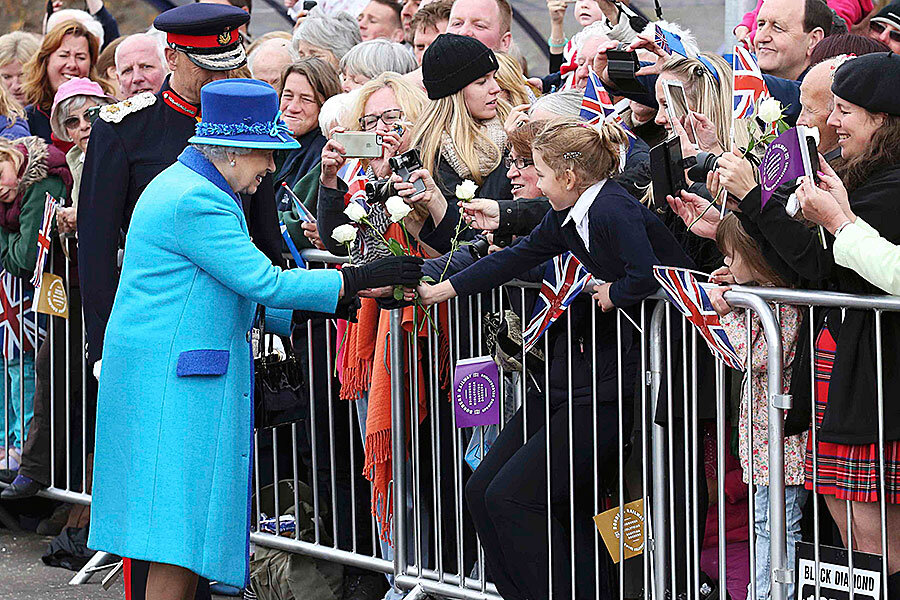How has Queen Elizabeth made those 63 years count?
Loading...
| Edinburgh
Britain paid heartfelt tribute to Queen Elizabeth on Wednesday with cheering, flag-waving crowds on the street and solemn messages in parliament as she sealed a special place in the country's history by becoming its longest-reigning monarch.
At about 5.30 p.m., Elizabeth, who now aged 89 is also the nation's oldest ever monarch, will surpass the 63 years, 7 months, 2 days, 16 hours and 23 minutes that her great-great-grandmother Queen Victoria spent on the throne.
"Her Majesty the Queen inspires us all with her incredible service and her dignified leadership and the extraordinary grace with which she carries out her duties," Prime Minister David Cameron told parliament in London.
"The Queen is our Queen and we could not be more proud of her. She has served this country with unfailing grace, dignity and decency and long may she continue to do so," Cameron said. Lawmakers cheered at the end of his tribute.
In central London, the BT Tower flashed "Long may she reign" around its screens nearly 200 meters above the capital.
Those close to the queen say she is fairly blase about the milestone, believing it represented little more than the fact she has lived for a long time and that her father, King George VI, died early.
Initially she did not even intend to mark the event publicly, but she bowed to public pressure and undertook an official engagement in Scotland, where she traditionally spends her summer holiday.
Crowds greeted her arrival accompanied by husband Prince Philip, who has been at her side throughout her reign, at Edinburgh's Waverley station before she began a journey on a steam train to mark the opening of the longest railway to be built in Britain for more than 100 years.
"It's brilliant," said May Marshall, wearing a jacket and hat covered in Britain's Union Jack flags. "No one else will ever do it. It's testimony to her stamina."
Elizabeth smiled broadly as she boarded the train. A Buckingham Palace spokeswoman said she might make a rare public speech afterwards.
'Long may she reign'
"It's inevitable that I should seem a rather remote figure to many of you, a successor to the kings and queens of history," she had said in her first televised Christmas broadcast in 1957.
"I cannot lead you into battle. I do not give you laws or administer justice. But I can do something else. I can give you my heart and my devotion to these old islands and to all the peoples of our brotherhood of nations."
As a young princess, Elizabeth had not expected to become monarch as George VI only took the crown when his elder brother Edward VIII abdicated in 1936 to marry American divorcee Wallis Simpson.
She was 25 when she ascended to the throne on Feb. 6, 1952, following George's death.
That made her the 40th monarch in a royal line that traces its origin back to Norman King William the Conqueror who claimed the throne in 1066 with victory over Anglo-Saxon Harold II at the Battle of Hastings.
The year she became queen, the Korean War was raging, Joseph Stalin was leader of the Soviet Union and Britain announced it had the atom bomb.
"There is a motto which has been borne by many of my ancestors - a noble motto, 'I serve,'" Elizabeth said in a televised speech to mark her 21st birthday.
"I declare before you all that my whole life, whether it be long or short, shall be devoted to your service and the service of our great imperial family to which we all belong."
Since becoming queen, she has seen 12 prime ministers, starting with Winston Churchill, and there have been 12 U.S. Presidents, from Harry S. Truman to Barack Obama.
Not only has Elizabeth reigned the longest but according to a poll in the Sunday Times this week, Britons also think she is the country's greatest monarch, ahead of her Tudor namesake Elizabeth I and Victoria, who was queen for much of the 19th century when Britain built up its empire.
Now, Elizabeth is queen of just 16 realms, including Australia and Canada.
However, despite the torrent of tribute, not everyone was impressed.
Republicans said her silence on political matters was her finest achievement, and well-known British historian David Starkey remarked that she had never said or done anything memorable in all he years on the throne.
"She will not give her name to her age. Or, I suspect, to anything else," Starkey wrote in the Radio Times magazine.
Editing by Stephen Addison and Guy Faulconbridge







